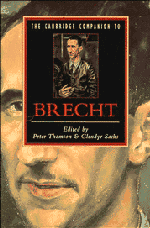Book contents
- Frontmatter
- PART 1 CONTEXT AND LIFE
- PART 2 THE PLAYS
- 3 Brecht's early plays
- 4 The Threepenny Opera
- 5 Brecht's clowns: Man is Man and after
- 6 Learning for a new society: the Lehrstück
- 7 Saint Joan of the Stockyards
- 8 The Zelda syndrome: Brecht and Elisabeth Hauptmann
- 9 The Good Person of Szechwan: discourse of a masquerade
- 10 Mother Courage and Her Children
- 11 Heavenly food denied: Life of Galileo
- 12 The Caucasian Chalk Circle: the view from Europe
- PART 3 THEORIES AND PRACTICES
- Bibliography
- Index of Works
- General Index
12 - The Caucasian Chalk Circle: the view from Europe
from PART 2 - THE PLAYS
Published online by Cambridge University Press: 28 May 2006
- Frontmatter
- PART 1 CONTEXT AND LIFE
- PART 2 THE PLAYS
- 3 Brecht's early plays
- 4 The Threepenny Opera
- 5 Brecht's clowns: Man is Man and after
- 6 Learning for a new society: the Lehrstück
- 7 Saint Joan of the Stockyards
- 8 The Zelda syndrome: Brecht and Elisabeth Hauptmann
- 9 The Good Person of Szechwan: discourse of a masquerade
- 10 Mother Courage and Her Children
- 11 Heavenly food denied: Life of Galileo
- 12 The Caucasian Chalk Circle: the view from Europe
- PART 3 THEORIES AND PRACTICES
- Bibliography
- Index of Works
- General Index
Summary
Written between 1941 and 1944 during Brecht's exile in the United States, The Caucasian Chalk Circle is made up of two stories, Grusha's, which starts in Scene 2, and Azdak's, which does not begin until Scene 5, the penultimate scene of the play. These two stories converge in Scene 6 where the problems that had been posed at the outset and highlighted throughout the sequences involving Grusha are resolved, thus bringing the whole action to a more or less 'happy' end. Since happy endings are not characteristic of Brecht's drama, this particular example of harmonious conclusion to anything but harmonious events (and to anything but a transparent argument) has prompted a number of commentators to draw special attention to the 'liberating, life-enhancing quality' of the play or its 'unified understanding'. The scholars who emphasise the joyful, morally affirmative and/or politically optimistic outlook provided by the play's denouement are usually also the ones who believe its two stories are organically linked. Their opinion runs counter to the authoritative view of John Willett and Ralph Manheim for whom the work is an 'awkward combination of two largely unrelated stories', despite which it is nevertheless 'a truly epic work embodying many of Brecht's special ideas, tastes, and talents'.
- Type
- Chapter
- Information
- The Cambridge Companion to Brecht , pp. 153 - 164Publisher: Cambridge University PressPrint publication year: 1994
- 1
- Cited by

